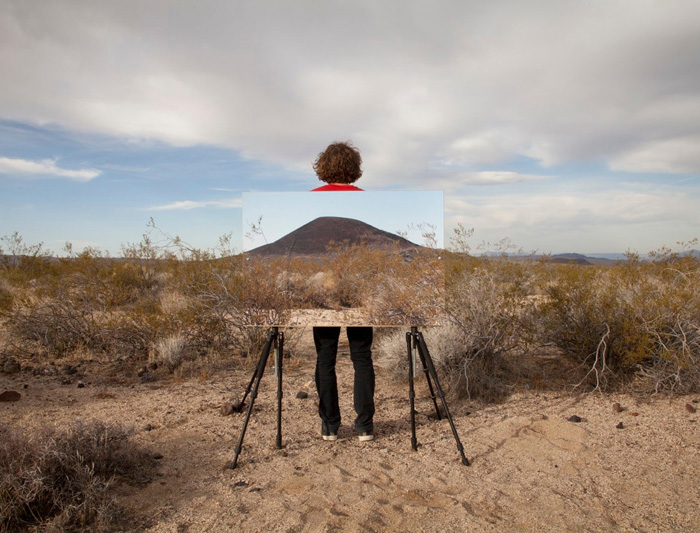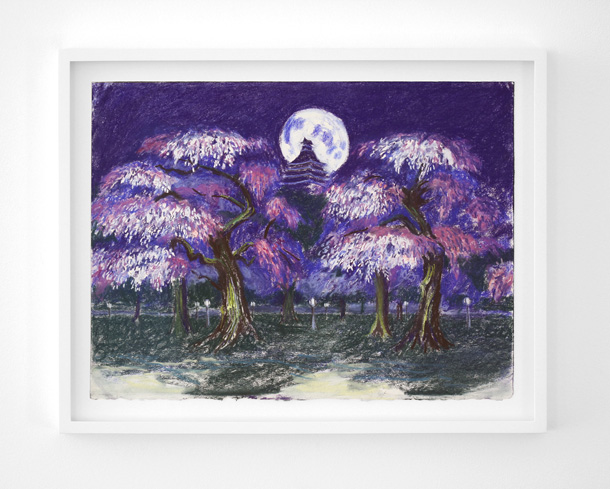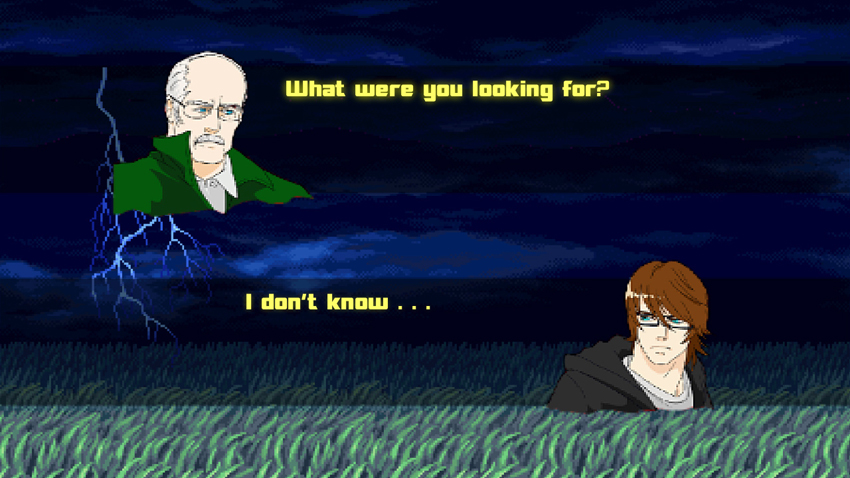
Richard T. Walker’s three-channel video projection, the speed and eagerness of meaning (2011), sees the artist wandering across the epic expanses of the Mojave Desert on a quest for revelation; a pilgrimage in search of the sublime. As he traverses the vast barren landscape, a monologue describes the insurmountable chasm he encounters between meaning and affect:
As you try to assemble what is now before you, you mourn a little for what you have lost, for you could never again acquire the not knowing that so beautifully placed you in the centre of it all. Now you can only draw parallels, assign differences, translate things into opposites, find commonalities, draw distinctions and embrace the overarching failure of all this togetherness.
Walker has made his way to this remote corner of the globe from his native Britain in order, in that most clichéd of fashions, to find himself, to be ‘at one’ with the world. And yet, as he begins to experience the reality of his vision of unbound nature, he cannot help but collapse what he sees back again onto a familiar pictorial plane, constrained by language and proportion. The compulsion to command and compartmentalise nature appears overpowering, cementing man’s place at the centre of the world, imposing order like one of those “frock coats” so despised by Bataille (who instead envisioned an essentially formless universe).
The great American landscape has long resonated in popular culture as a site of ultimate romantic escapism, from the seductive wilderness of Marlboro Country advertisements, to countless film and television productions. Walker himself cites ‘couple on the run’ movies such as Badlands, Bonnie & Clyde, Gun Crazy and Natural Born Killers, where “the theme seems to be that in order for the couples to be together they are forced to transgress, often committing successive crimes and escaping civilization for the limitless bounds of the American landscape. It is only here that their love can exist.”
But in Walker’s works we find no violence, no romanticised form of Bataillean transgression that might act as an ultimate gateway to the Real. The subject of Walker’s love is instead the landscape itself, his works centring on an intense, solitudinous relationship with nature. He engages in the pathetic fallacy, anthropomorphising the land as an entity capable of reciprocating his desires. And yet the landscape remains impassive; a love destined to be perpetually unrequited.
As with all desires, there is the hope that a kind of deeper essence might somehow be attained; that was the promise of all those alluring depictions of this once faraway land. The artist’s frustration upon arriving is that he can at first only recognise a superficial blanket of appearances smothering all before him — “the speed and eagerness of meaning”. Eventually, however, he begins to sense that in order to know the unknown, one must unknow the known. He attempts to lose himself to the landscape, to his feelings, surrendering his position at the centre of it all. What is now described is the simultaneous beauty and terror of the sublime, fraught with the anxiety of losing one’s place in the vastness of the cosmos:
He can’t describe anything he sees because nothing fits into words anymore. He occasionally experiences feelings that are associative to the things in front of him but they exist between and beyond emotions, so translation is impossible. He wants to see things as they were. With the ability to ascribe meaning and names to objects again, finding purpose and justification even if it isn’t true. He wants everything to be just what it was.
His search has thus come full circle, from the analytical to the sensual and back, with the fear of a loss of control proving an unbearable obstacle. But rather than simply abandon his quest, or continue in circles ad absurdum (as might be the postmodernist’s curse), he instead pursues a third path, attempting a performative engagement with the landscape that endeavours to transcend its phenomenological bounds. He picks up a guitar and begins to strum a simple, cyclical tune. He starts to gently beat a drum, to pluck the strings of a banjo, to add track upon track of wordless vocals. As the layers of lo-fi sonic texture begin to mount, the wistful intensity builds. The music acts as both a love song to the sublime, and a lament for what has been lost in its pursuit. Audible as a whole only in this final multi-channel edit, the arrangement also serves to highlight the fragmentary nature of experience and the illusory allure of images.
In other works such as let this be us (2012), the artist attempts quite literally to align images of nature with reality, as he treks across the land with photographic prints mounted on tripods, searching for viewpoints where the two will seamlessly merge. There is a simultaneous sense of joy, absurdity and disappointment in this act. Once the perfect perspective is found, an inherent failure reveals itself, foregrounding the discrepancy between visions and reality — each lacking something of the other, and neither encompassing the desired whole.
Inevitably in these pieces, the artist is seen vanishing into the distance, never once looking back towards the lens, carried away on a current of musical earnestness. This act of riding into the sunset thus presents an ambiguous conclusion, both resolved and unresolved, as filmic fantasy of romantic fulfilment, and document to the perpetual longing for elusive horizons.
David Blandy is another artist whose quests have led him to faraway lands. To the crossroads of the Deep South, retracing Robert Johnson’s footsteps, where he attempted to make a Faustian pact with the Devil. To the rebuilt metropolis of Hiroshima, where he explored his family’s wartime history alongside the imagery of post-apocalyptic anime, reinventing himself in cartoon superhero form as the Child of the Atom. Blandy adopts a range of alter egos in his works as he pursues the fantasies and mythologies of popular culture in search of self-transformation. Endearingly, however, he is never quite able to fully transcend his own self-effacing identity. Instilled with a spirit of irony and sincerity, these characters instead become surrogates for the artist’s own voyage of self-discovery.
In Duels and Dualities (2011), Blandy presents a Street Fighter style arcade machine in which the characters have been replaced with the artist’s various alter egos — The Barefoot Lone Pilgrim, The White and Black Minstrel, the all-powerful Child of the Atom — each with their own arsenal of special moves and superpowers. Doing battle with them, however, is the David Blandy character, appearing this time as himself, humorously equipped with only “a hard and a weak punch”. Blandy predictably becomes cannon fodder for his onslaught of alter ego opponents, as they hurricane-kick and sonic-boom his avatar to oblivion. Witty and profound, the work proves the artist remarkably easy to beat at his own game (in a most un-Duchampian manner), highlighting the futility and triumph of art’s transformative promise.
Blandy’s videogame interventions differ dramatically from those of artists such as Cory Arcangel, whose works are saturated with unabashed irony. Arcangel is obsessed with the anti-aesthetic of default settings, and the computer’s inability to stray from a pre-programmed course. His 2011 installation, Beat the Champ, consisted of 14 consoles running ten-pin bowling games, modded in such a way that the computer plays itself, throwing a gutter ball each and every time. The computer always loses, again and again, forever hapless and hopeless. There is a certain throwaway charm to this geeky Sisyphean one-liner, but its closed loop is perhaps indicative of a wider cynical disregard for art’s imaginative potential. Arcangel appears content to assume the role of nihilistic jester — to have nothing to say, and to say it.

Blandy’s works, by contrast, utilise nostalgic, retro technologies to emphasise the enduring power of imagination. His latest project, Background (2013), sees the artist collaborating for the first time with his father, John, who is himself a landscape artist. Blandy senior’s pursuit of nature over the years has led him to depict the same lime tree over 2500 times, documenting its daily development amid the passage of the seasons. Here, however, he has been commissioned to produce a series of pastel drawings of landscapes quite alien to him, assigned the task of depicting the backgrounds from an assortment of 90s fighting games such as Last Blade, Samurai Shodown IV, King of Fighters 99 and Vampire Saviour. Sensitively interpreting these exotic lands, the resultant images portray a peculiar sense of placelessness, as studies of the site of another’s fascination.
For David Blandy, these pixelated videogame vistas resonate in a similar way to Walker’s beloved images of the American West. They function as a ‘great outdoors’, as places of 16-bit dreams where fantasies can be enacted, offering the promise of some kind of metaphysical or supernatural becoming. The accompanying video to this work sees Blandy and his father rendered in virtual form, appearing as on-screen sprites wandering through the flickering digital lands. The pair engage in a conversation about their artistic hopes and aspirations, with the son seeking guidance from his elder, as if quizzing an in-game sage for vital nuggets of knowledge. They discuss the realities of making art, of surviving and supporting a family, and the difficulties in trying to overcome the weight of art history and push their works onwards. Ultimately there are no easy answers to be found, no straightforward routes to reach artistic goals. The dialogue across generations is touching, however, for it displays each artist’s willingness to engage with the other’s domain, united by their overlapping, though divergent journeys.
Far from presenting a series of closed narratives, works such as these speak of a determination to level up, to pursue that obscure object of artistic desire. Both Blandy and Walker are representative of the broader return of the Quest in contemporary culture, following an era of works that sought nothing more than sensationalism, reflecting a cautious metamodern optimism for something beyond our horizons that art might somehow glimpse. Whether it be truth, self-discovery, or some other entirely intangible essence, this remains a path well worth treading.


Richard T. Walker’s show ‘in defiance of being here’ runs until 13th April at Carroll / Fletcher.
David Blandy’s ‘Background’ is on display until 23rd March at Seventeen Gallery.
Artworks (from top):
Richard T. Walker: let this be us (still) (2012), the speed and eagerness of meaning (excerpt) (2011), let this be us (excerpt) (2012).
David Blandy: Duels and Dualities (2011), Background (2013), Night Blossom (Samurai Showdown IV) (2013), Background (still) (2013).
All works © the artists.
